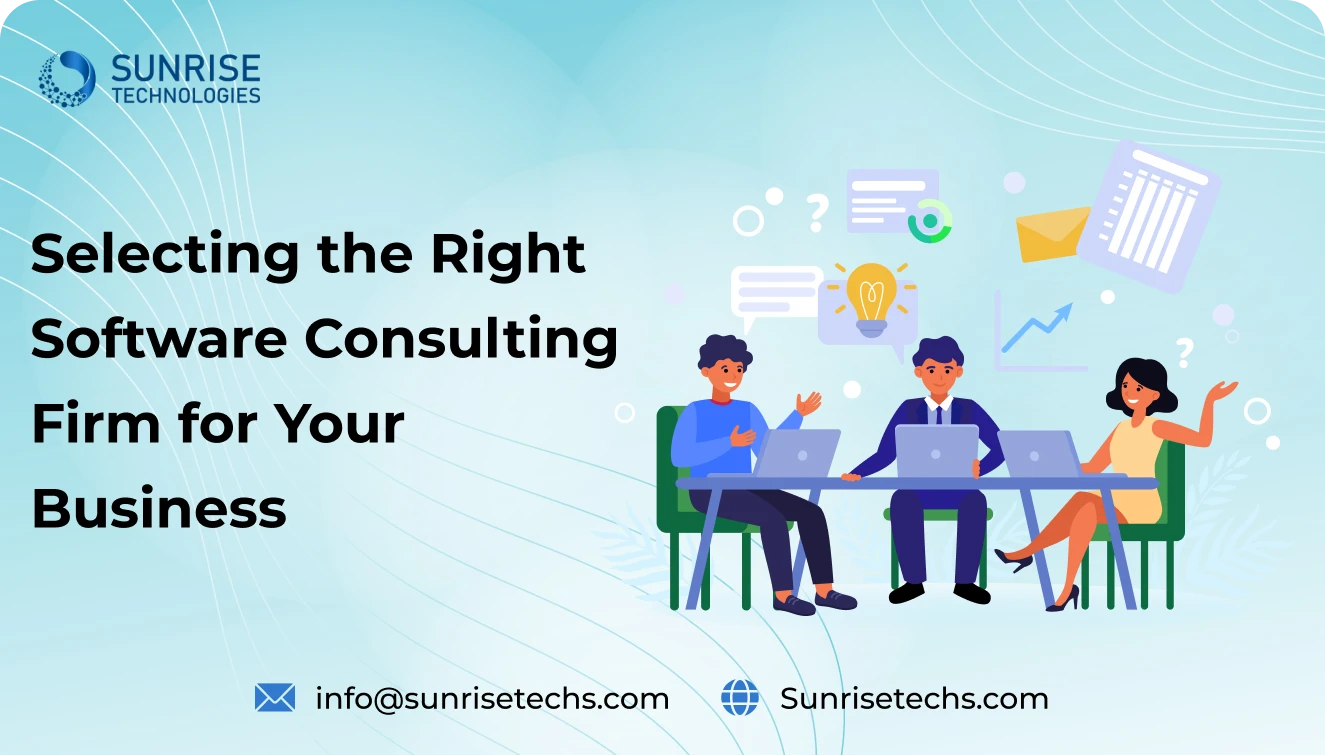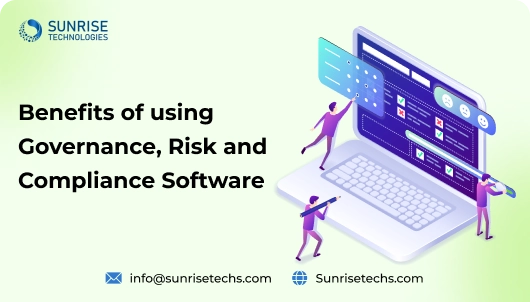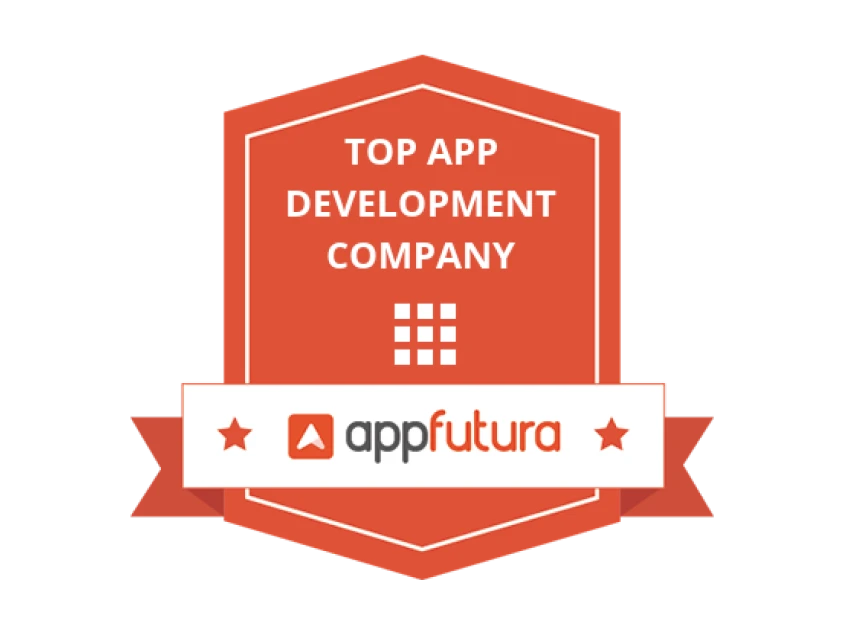
Top 14 AI Trends to Embrace in 2024
April 11, 2024
As we step into 2024, the landscape of artificial intelligence (AI) is poised for yet another transformative leap forward. Reflecting on the rapid evolution witnessed in the past years, it’s evident that generative AI, once confined to the realms of research labs, has now firmly entrenched itself in the fabric of our daily lives and businesses.
The journey of generative AI closely parallels that of computers, albeit at an accelerated pace. From the emergence of massive mainframe computers dominated by a few key players to the proliferation of accessible computing power in enterprises and research institutions, the trajectory has been one of continual advancement. As we moved through the decades, incremental improvements paved the way for the democratization of computing, culminating in the ubiquity of powerful personal computers with user-friendly interfaces.
However, it was in the preceding years of 2022 and 2023 that generative AI truly came into the limelight, capturing the imagination of the public and finding practical applications in diverse industries. Now, as we stand on the threshold of 2024, the focus shifts towards harnessing the full potential of this groundbreaking technology and seamlessly integrating it into our everyday lives.
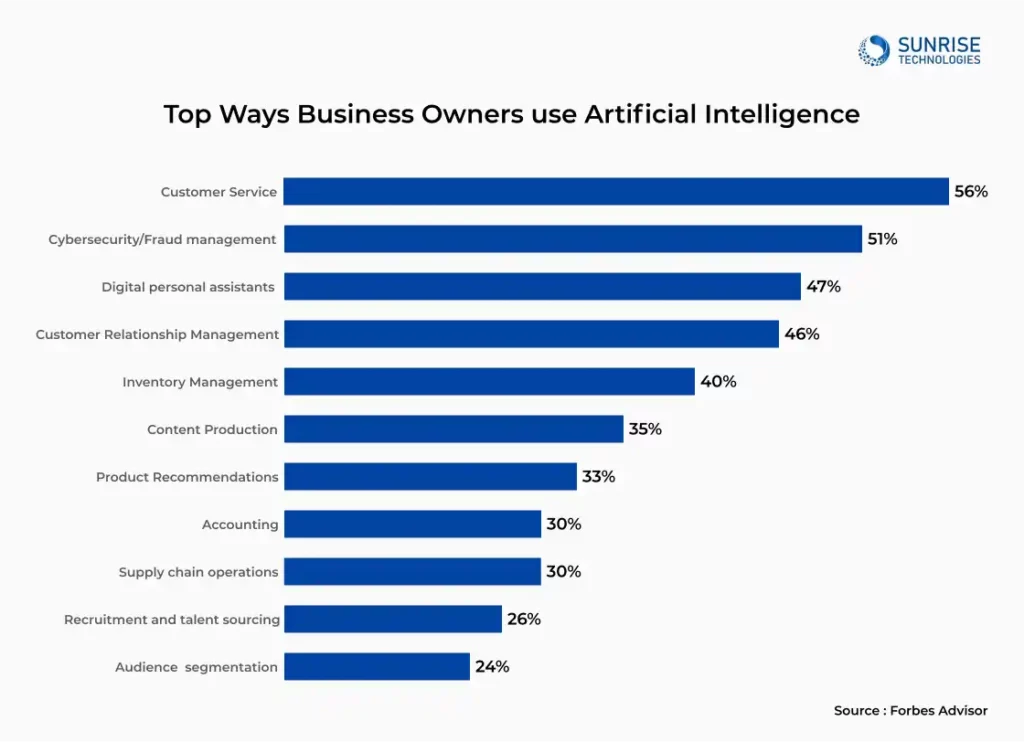
14 AI trends in 2024
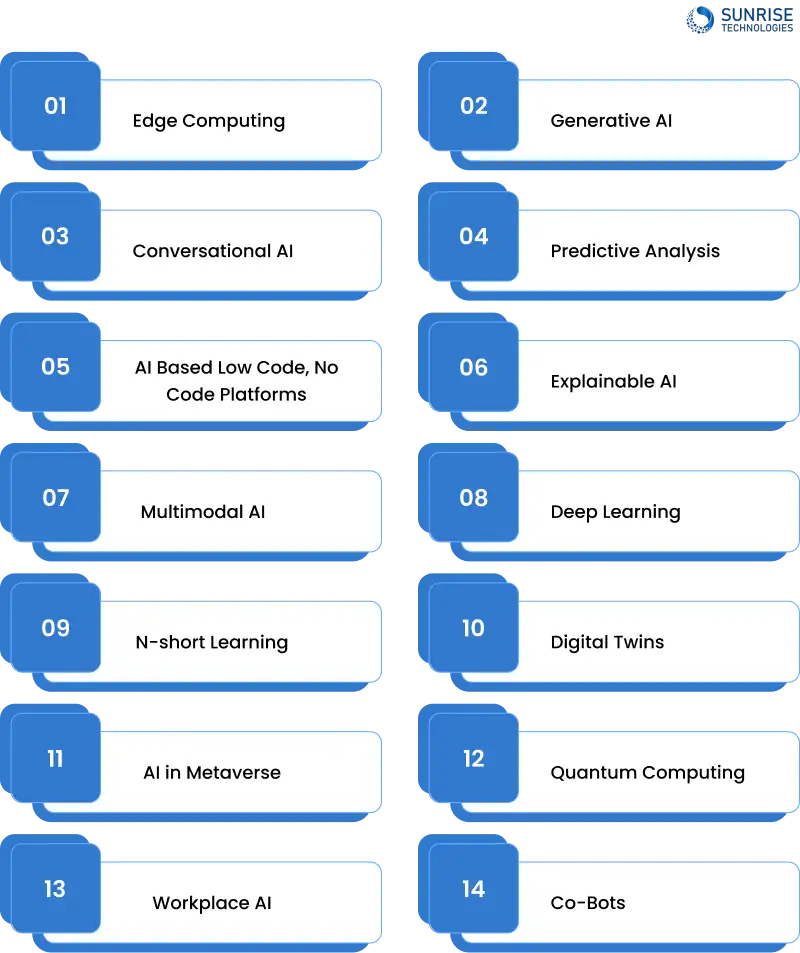
1. Edge Computing:
Edge computing plays a vital role in modern distributed computing. It brings computation closer to the sources of data, enabling faster data processing. This proximity allows for efficient local data analysis, reducing bandwidth consumption and network delay. By reducing the need to transfer data to distant centralized locations, edge computing improves performance and optimizes resource usage. Edge computing is crucial for industries that require high efficiency and quick response times. It empowers organizations to remain agile and competitive in the fast-paced digital world. By leveraging edge computing, companies can drive innovation and create new opportunities.
2. Generative AI:
Generative AI is emerging as one of the most significant trends in artificial intelligence. Generative AI provides businesses with unprecedented opportunities to generate new data, new content, and new visual assets. Generative AI algorithms use sophisticated machine learning techniques to analyze existing data sets and generate new, creative outputs across a wide range of domains, including text, images, 3D models, and more. Generative AI is revolutionizing industries like manufacturing and automotive, as well as architecture, where it helps optimise design processes, accelerates product development cycles and boosts creativity. As the field of generative AI advances, its potential for driving innovation and unlocking new opportunities in content and design remains unrivaled, paving the way for an AI-driven future of creativity and productivity.
3. Conversational AI
Conversational AI is emerging as one of the most important trends in the field of AI, and it’s going to change the way people interact with technology. Through the use of NLP (natural language processing) and machine learning (ML), conversational AI systems allow users and machines to communicate with each other in both spoken and written language.
Today, conversational AI is used in a wide variety of industries, including customer service chatbots, virtual assistants, voice-enabled smart devices, and even language translation services. Deep learning and neural networks are driving the development of conversational AI, and it promises to deliver more personalized, efficient and intuitive user experiences that will drive innovation and change the way we interact with technology.
4. Predictive Analysis
Predictive analysis stands at the forefront of AI trends, offering businesses invaluable insights into future outcomes based on historical data and statistical algorithms. By harnessing machine learning and data mining techniques, predictive analysis enables organizations to forecast trends, identify patterns, and make informed decisions across various domains.
From predicting customer behavior and market trends to optimizing supply chain operations and mitigating risks, the applications of predictive analysis are vast and diverse. As businesses strive to stay ahead in a competitive landscape, the ability to anticipate future events and trends becomes increasingly crucial, making predictive analysis an indispensable tool for driving growth, efficiency, and strategic decision-making.
5. AI Based Low Code, No Code Platforms
driven low-code / no-code platforms are changing the way software development works. People with limited coding knowledge can now create complex applications with ease. AI-driven platforms automate repetitive tasks and simplify the development process. These platforms help speed up app development and drive innovation. AI-driven, agile, and open software development is paving the way for digital transformation across industries.
6. Explainable AI
Explainable AI acts as the bridge between humans and the AI systems. It provides insight into the techniques and processes used by AI to achieve a specific result. This transparency increases trust in AI and improves decision-making precision. In the near future, industries like healthcare and human resource will see a strong focus on interpretability. This will ensure responsible and dependable adoption of AI across a wide range of areas. As AI evolves, the need for explainable solutions will continue to grow, stimulating innovation and building trust in AI technology across different industries.
7. Multimodal AI
Multi-modal Artificial Intelligence (MMA) is a new trend that is changing the way artificial intelligence works. It can process and understand information from multiple data sources at the same time. In the past, AI models were limited to a single type of data like text or images. However, now MMA integrates different types of data like text and images, audio and video, etc. This allows for a better understanding of complex input. As the need for smarter and more versatile AI solutions increases, MMA is expected to be at the forefront of innovation and shape the future of AI.
8. Deep Learning
The ability to mimic the human brain’s ability to perform tasks has been extremely useful in processing large amounts of data. It’s becoming more and more popular because it has multiple layers of processing that help to improve the model’s accuracy. Common applications can be found in the development of products by companies like autonomous driving vehicles, over-the-top (OTT) platforms, personalized experiences of online shopping platforms, and many more.
9. N-short Learning
N-short learning is one of the AI trends in 2024 which refers to a specialized approach in artificial intelligence aimed at rapidly acquiring knowledge and adapting to new tasks in a short period. Unlike traditional learning methods that may require extensive training data and time, N-short learning focuses on efficiently learning from limited data points, enabling quicker adaptation to changing environments or tasks.
This trend is gaining traction due to its applicability in scenarios where data availability is scarce or where rapid learning and decision-making are paramount. Industries such as cybersecurity, financial trading, and medical diagnosis stand to benefit greatly from N-short learning techniques, as they enable AI systems to swiftly adapt to emerging threats, market trends, or medical conditions.
10. Digital Twins
Digital Twin is revolutionizing industries by creating virtual replicas of physical assets, systems, or processes. This technology enables real-time monitoring, analysis, and optimization of physical assets or systems by pairing them with their digital counterparts. By leveraging advanced AI algorithms, Digital Twins simulate real-world scenarios, allowing organizations to gain deeper insights, predict performance, and identify potential issues before they occur.
This trend finds applications across various sectors, including manufacturing, healthcare, and smart cities, where it facilitates predictive maintenance, personalized healthcare interventions, and efficient urban planning. As Digital Twins continues to grow, fueled by advancements in IoT sensors, cloud computing, and AI, it promises to drive innovation, improve operational efficiency, and unlock new opportunities for businesses and society.
11. AI in Metaverse
AI in the Metaverse is a revolutionary trend, ushering in a new era of interactive digital experiences. Virtual worlds are becoming more advanced and expansive, and AI plays a key role in increasing realism, interactivity and personalization in these digital worlds. AI-powered algorithms in virtual environments can react to user interactions, adjust to user preferences, and even create real-time content.
From realistic avatars and AI-powered natural language processing for real-time conversations to intelligent NPC (non-player) characters and adaptive environments, artificial intelligence is enriching the Metaverse experience and blurring the boundaries between the virtual and the physical worlds.As the Metaverse evolves into a multi-faceted ecosystem, AI integration promises endless opportunities for creativity, collaboration and exploration, transforming the way we engage, work and socialise in the digital world.
12. Quantum Computing
Quantum computing is a game-changer in the world of AI, ushering in a new age of unrivaled computing power. Unlike conventional computing models, quantum computers use quantum mechanics to convert information into quantum bits, also known as qubits, dramatically increasing the speed and capacity of computing. The quantum advantage allows quantum computers to solve complex AI problems with unprecedented speed and efficiency, from optimizing algorithms, machine learning models, and algorithms to solving cryptography, data analysis, and more.
As quantum computing technologies advance, they have the potential to revolutionize the artificial intelligence landscape, unlocking new areas of innovation and driving transformative progress across a wide range of industries in the near future. From drug discovery to financial modeling to natural language processing, quantum computing has the potential to transform the way we think, act, and learn.
13. Workplace AI
Workplace AI is the trend which is reshaping the world, Workplace AI solutions streamline workflows, increase efficiency, and drive innovation within the workplace. Automate repetitive tasks and provide personalized insights, enabling employees to concentrate on strategic work while efficiently managing day-to-day operations. Workplace AI facilitates smooth collaboration and communication across multiple teams and locations, enabling effective teamwork. As businesses continue to digitalize, integrating Workplace AI becomes a key strategy for increasing productivity, flexibility, and competitive edge in today’s fast-paced work environment.
14. Co-Bots
Co-bots are one of the fastest-growing robotics and automation technologies. Unlike conventional industrial robots, which are large, cage-like, and operate on their own, co-bots work in a shared workspace with humans. These high-tech co-bots have built-in security features that enable them to operate in near-field proximity to workers without putting them at risk. Co-bots are easy to program, retrain, and redeploy for various tasks.
Companies are looking for ways to increase productivity while still maintaining a human workforce. Co-bots offer an attractive solution by augmenting and enhancing human capabilities rather than completely replacing them. Co-bots have become increasingly affordable and easy to use, leading to their widespread adoption across industries such as manufacturing, logistics and healthcare.
AI with Emerging Technologies : A New AI Trend
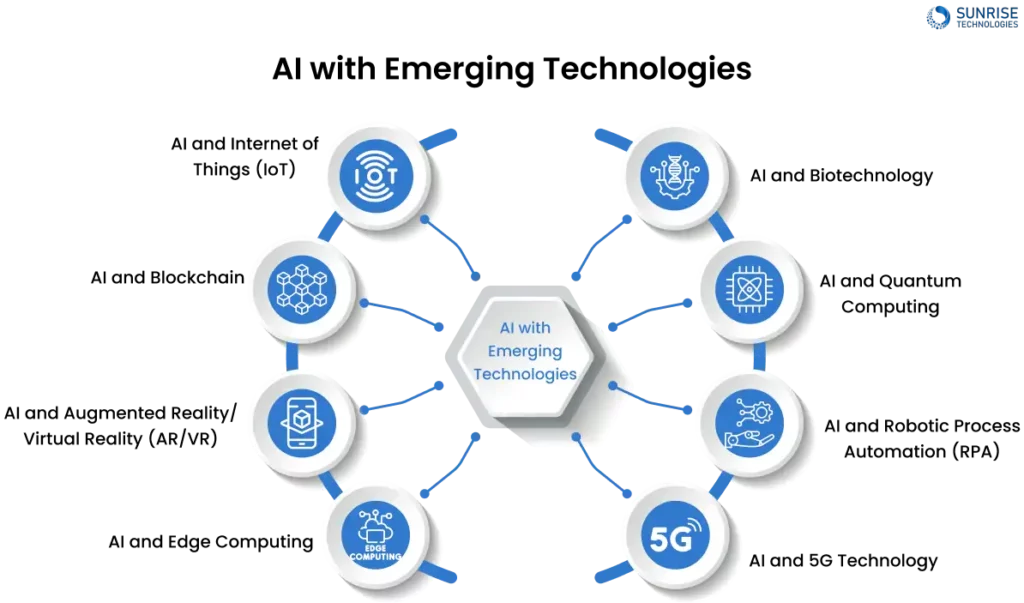
Combining AI with other emerging technologies can lead to synergistic effects, enabling innovative solutions across various domains. Here are some trends emerging from the combination of AI with other technologies:
AI and Internet of Things (IoT):
- Smart Environments: AI algorithms can analyze data from IoT sensors to optimize energy consumption, improve safety, and enhance user experience in smart homes, cities, and industries.
- Predictive Maintenance: By applying AI to IoT sensor data, predictive maintenance models can anticipate equipment failures, reducing downtime and maintenance costs.
AI and Blockchain:
- Secure Data Sharing: AI algorithms can analyze blockchain data for insights while ensuring data privacy and integrity, facilitating secure data sharing across organizations.
- Fraud Detection: AI combined with blockchain technology can enhance fraud detection and prevention in financial transactions by analyzing patterns and anomalies in transaction data stored on the blockchain.
AI and Augmented Reality/Virtual Reality (AR/VR):
- Immersive Experiences: AI algorithms enhance AR/VR experiences by enabling real-time object recognition, natural language processing for voice interactions, and personalized content recommendations.
- Training and Simulation: AI-powered simulations in VR environments can provide realistic training scenarios for various industries, including healthcare, defense, and manufacturing.
AI and Edge Computing:
- Real-Time Processing: AI algorithms deployed on edge devices enable real-time data processing, reducing latency and bandwidth usage in applications such as autonomous vehicles, smart surveillance, and industrial automation.
- Privacy Preservation: Edge AI allows sensitive data to be processed locally, preserving user privacy by minimizing the need to send data to centralized servers.
AI and Biotechnology:
- Drug Discovery: AI accelerates drug discovery processes by analyzing large datasets, predicting drug-target interactions, and designing novel compounds with desired properties.
- Precision Medicine: AI algorithms analyze genomic and clinical data to personalize treatment plans and predict patient outcomes, advancing the field of precision medicine.
AI and Quantum Computing:
- Optimization Problems: AI algorithms can leverage quantum computing's capabilities to solve complex optimization problems more efficiently, with applications in logistics, finance, and cryptography.
- Machine Learning Acceleration: Quantum computing techniques may accelerate certain machine learning tasks, such as training large-scale models and optimizing neural network architectures.
AI and Robotic Process Automation (RPA):
- Intelligent Automation: AI-powered RPA systems can automate repetitive tasks while also incorporating cognitive capabilities such as natural language processing and machine learning to handle more complex scenarios.
- Process Optimization: By analyzing large datasets and user interactions, AI-enhanced RPA solutions can identify inefficiencies in business processes and suggest optimizations for improved efficiency and cost savings.
AI and 5G Technology:
- Real-Time Data Processing: AI algorithms deployed on 5G networks can process and analyze data in real-time, enabling low-latency applications such as autonomous vehicles, augmented reality, and remote healthcare.
- Network Optimization: AI-driven network management techniques can optimize 5G infrastructure, dynamically allocating resources, mitigating congestion, and ensuring efficient data transmission to support a wide range of connected devices and services.
AI Trends and Use Cases Across Industries
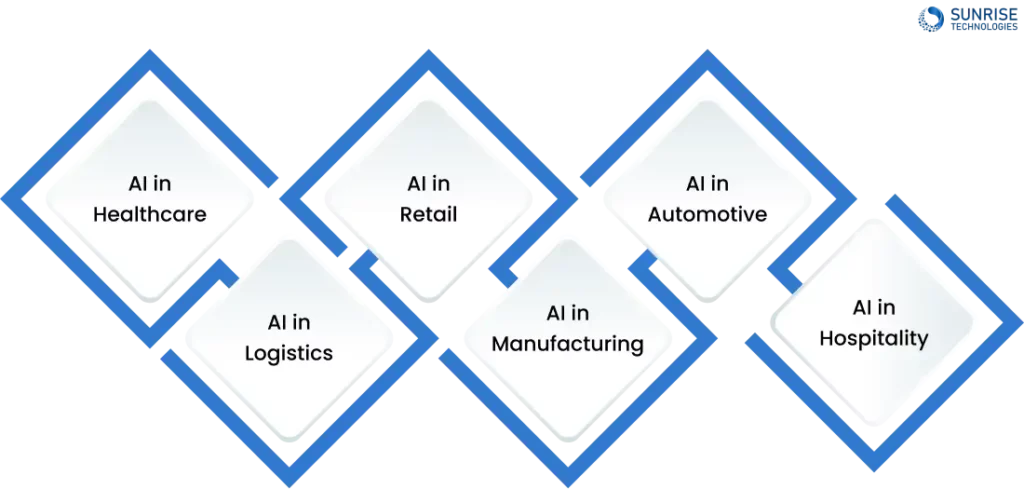
AI in Healthcare:
- Enhanced Diagnostics: AI algorithms analyze medical images and patient data to assist healthcare professionals in diagnosing diseases and identifying treatment options with higher accuracy and efficiency.
- Personalized Treatment Plans: AI-driven predictive analytics enable personalized treatment plans by analyzing patient data, genetic information, and clinical records to tailor interventions and improve patient outcomes.
- Healthcare Management Optimization: AI optimizes healthcare operations by predicting patient admission rates, optimizing resource allocation, and streamlining administrative tasks, leading to improved efficiency and cost savings.
AI in Logistics:
- Route Optimization: AI algorithms optimize logistics routes by analyzing real-time data on traffic, weather, and transportation schedules, reducing delivery times and costs for businesses.
- Supply Chain Management: AI-powered predictive analytics enhance supply chain management by forecasting demand, identifying potential disruptions, and optimizing inventory levels to ensure timely delivery of goods.
- Warehouse Automation: AI-driven robotics and automation technologies streamline warehouse operations by autonomously sorting, picking, and packing items, improving efficiency and reducing labor costs.
AI in Retail:
- Personalized Shopping Experience: AI algorithms analyze customer data and browsing behavior to offer personalized product recommendations, discounts, and promotions, enhancing customer engagement and loyalty.
- Inventory Management: AI-driven demand forecasting models optimize inventory levels, minimizing stockouts and overstock situations, and improving overall supply chain efficiency.
- Visual Search and Recognition: AI-powered visual recognition technology enables customers to search for products using images, improving the shopping experience and increasing conversion rates.
AI in Manufacturing:
- Predictive Maintenance: AI algorithms analyze sensor data from manufacturing equipment to predict potential failures and schedule maintenance proactively, minimizing downtime and optimizing production efficiency.
- Quality Control: AI-powered computer vision systems inspect products for defects and anomalies during the manufacturing process, ensuring product quality and reducing waste.
- Process Optimization: AI-driven optimization algorithms optimize manufacturing processes by analyzing production data, identifying inefficiencies, and suggesting improvements to enhance productivity and reduce costs.
AI in Automotive:
- Autonomous Vehicles: AI enables the development of self-driving cars by processing sensor data, recognizing objects and obstacles, and making real-time driving decisions, leading to safer and more efficient transportation.
- Predictive Maintenance: AI algorithms analyze vehicle performance data to predict maintenance needs, reducing breakdowns and extending the lifespan of automotive components.
- Personalized In-Car Experience: AI-powered infotainment systems and virtual assistants personalize the driving experience by offering navigation assistance, entertainment options, and vehicle customization based on individual preferences.
AI in Hospitality:
- Guest Experience Enhancement: AI-powered chatbots and virtual assistants improve guest interactions by providing personalized recommendations, handling reservations, and addressing inquiries promptly.
- Revenue Management: AI-driven analytics optimize room pricing and availability based on factors such as demand, seasonality, and competitor rates, maximizing hotel revenue and occupancy rates.
- Operational Efficiency: AI algorithms optimize hotel operations by predicting peak demand periods, managing staff schedules, and automating routine tasks such as housekeeping and maintenance, leading to cost savings and improved guest satisfaction.
Partner with Sunrise Technologies to Harness the Power of AI Trends and Revolutionize Your Business
AI trends have the power to transform the future of businesses in all industries. With our deep industry knowledge and innovative solutions, we help organizations unlock new opportunities, optimize operations, and stay competitive. By embracing AI technologies, companies can streamline processes, improve decision-making, deliver personalized experiences to their customers, and drive growth and innovation.
Sunrise Technologies – best AI development company works closely with clients to customize AI solutions to meet their individual needs and goals. Whether it’s implementing predictive analytics for better decision-making or implementing AI-powered automation to increase efficiency, we’re dedicated to delivering measurable results that fuel business success. Join hands with Sunrise Technologies today and take the next step in transforming your business with today’s latest AI trends.
Sam is a chartered professional engineer with over 15 years of extensive experience in the software technology space. Over the years, Sam has held the position of Chief Technology Consultant for tech companies both in Australia and abroad before establishing his own software consulting firm in Sydney, Australia. In his current role, he manages a large team of developers and engineers across Australia and internationally, dedicated to delivering the best in software technology.



